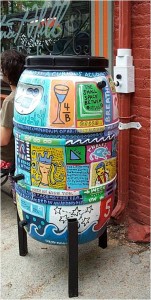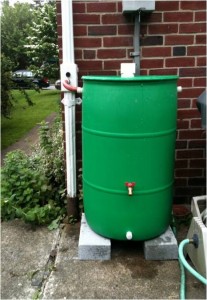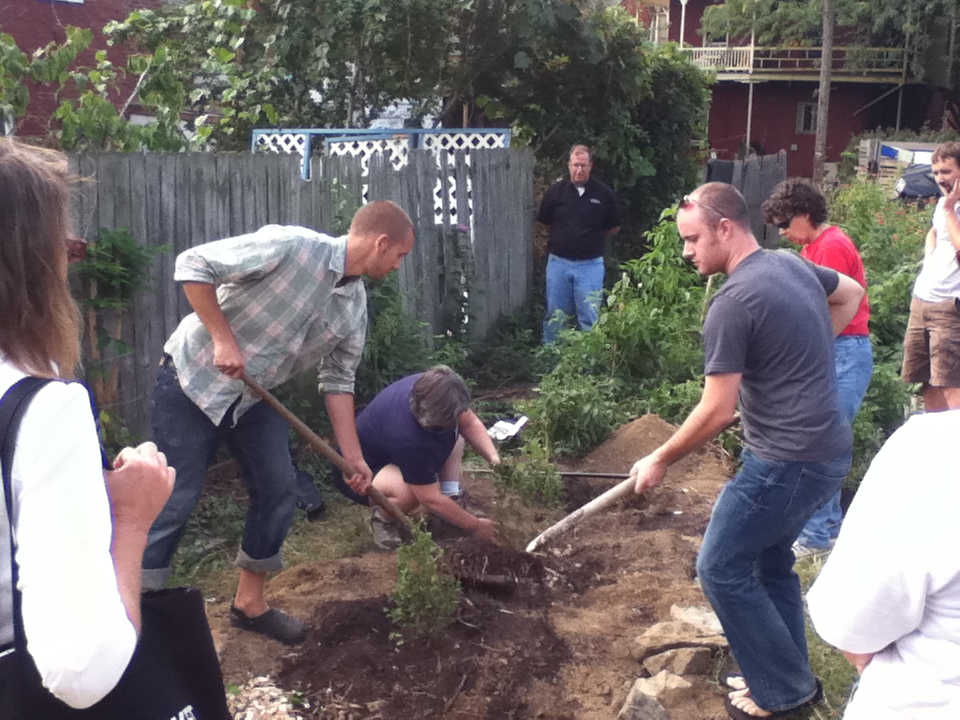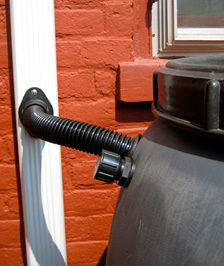Intermediate – I’ve got 5 hours, what can I do?
Install low-flow showerhead and aerators or a toilet dam
Install a low-flow showerhead to reduce your shower water use by 20 to 60 percent and put aerators on all your faucets, which can reduce your water flow by two gallons per minute.
Install a toilet dam. Toilets use about 40 percent of the water we use in our homes – up to 3.5 gallons per flush. The Environmental Protection Agency (EPA) estimates that in the U.S. more than 4.8 billion gallons of water are flushed down toilets each day. If your toilet was installed before 1992, add a toilet dam ($4.99 – $8.99) to reduce the amount of water flowing out of it by 35 percent and still leave it functioning properly. (Never use a brick to displace water in the tank, because it can deteriorate and clog your pipes.)


Disconnect and Redirect Downspouts
There are a variety of things you can do to capture some or all of that water before it enters the combined sewer system including:
Redirecting your downspout to a green area where the rainwater will be able to soak into the ground. Be careful here – you don’t want to put too much rainwater into an area that can’t absorb it. So how do you know? Downspout Disconnection (PDF)
- Installing a rain barrel to capture water from a downspout. The effectiveness of rain barrels (or cisterns) is a function of their storage volume in comparison to the size of the roof. In a simple residential example, a 1,200 square foot roof could utilize 60-gallon barrels to store runoff from downspouts at the four corners of a house. The resultant storage is equivalent to about .3 inches of runoff. While this volume will not substantially reduce flooding from large storms, it can considerably reduce direct runoff from smaller storms and divert water from the combined sewer system. The actual effectiveness of this approach depends on you! Rain barrels must be regularly emptied between storm events and the water can be used for watering plants or can simply be released back into the combined sewer system when it is not raining. The reason that the slow release is still effective is that the treatment plant has the capacity after large rain events to treat the rainwater that you are now releasing back into the system. The CSO events are over by the time you are releasing this stored rainwater. Cistern / Rain Barrel (PDF)
- Installing a container garden to capture water from a downspout. Container gardens, above ground or below ground, can help capture rainwater. Container gardens are often used along the sides of buildings or sidewalks to add green space in tightly confined urban areas. They can take on a number of different configurations and above ground planters can be made of a variety of materials including brick, stone, ceramic, wood and metal. Underground container gardens can be constructed alongside buildings provided that proper waterproofing measures are used to protect foundations. Stormwater Planter Box (PDF)
Plant a Tree
Trees are not only a beautiful addition to the landscape, but they also provide invaluable benefits to urban communities. They cool your home on hot, sunny days, intercept rain as it falls, naturally manage large volumes of rainwater, clean the air and provide a noise buffer. Plant a Tree (PDF)
iTree provides an easy-to-use tree benefit calculator that creates a simple estimation of value. For example, using a relatively mature sugar maple with a five-inch round trunk shows it has the equivalent value of $48 per year in energy savings. The same tree will divert 338 gallons of rainwater, and offset 102 pounds of carbon emissions.

Remove some pavement
Walking down the street you might notice that some houses have concrete extending from their foundation all the way out to the curb. In some places, this is unavoidable because the sidewalk is already very narrow. However, in other places, there is plenty of room to remove some of the concrete along the front of a house or add a planting strip between the curb and the sidewalk.
Use native plants and mulch
Using native plants, also called conservation landscaping, means using plants for landscaping that require less watering and maintenance. Native plants have extensive root systems that can more readily absorb rainfall, thereby reducing stormwater runoff.
In addition to reducing stormwater runoff, conservation landscaping provides a host of other benefits. Deep-rooted native plants effectively stabilize soils and prevent erosion while providing habitats for native and migrating birds, butterflies and insects.
Mulch helps the ground retain moisture and rebuilds the quality of soil. A typical safe mulch can include bark mulch (not dyed), leaves, pine needles, wood chips, or straw.
What’s Next?
ADVANCED – I’ve got 5 Days, what else can I do?


